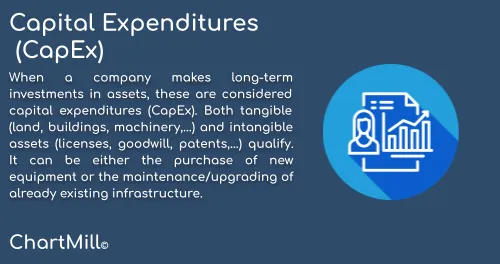Capital Expenditures (CapEx)
By Kristoff De Turck - reviewed by Aldwin Keppens
Last update: Apr 19, 2024
Capital Expenditures (CapEx)
When a company makes long-term investments in assets, these are considered capital expenditures. Both tangible (land, buildings, machinery,...) and intangible assets (licenses, goodwill, patents,...) qualify. It can be either the purchase of new equipment or the maintenance/upgrading of already existing infrastructure.
This type of financial expenditure is made by companies to increase the scale of their existing operations or to invest in new technologies that can then add a future economic benefit to the operation.
What is important here is that it has to concern expenditures on long-term assets. This refers to assets that can be found on the balance sheet for more than one year. This minimum time limit does not apply when the expense is intended to extend the life of an asset.
For capital expenditures, a further distinction can be made between operational investments, for example replacing equipment that has a lifespan of more than 1 year (otherwise they are operating expenses, see further on in this article) and those expenditures that are made for the purpose of further growth, expansion or improved efficiency.
Tangible vs Intangible fixed assets
Capex includes both tangible and intangible fixed assets.
Tangible assets include physical assets and refer to land and buildings, equipment, machinery, equipment,... Both for acquisition, maintenance, repairs and depreciation costs.
As for intangible assets, the non-physical assets are meant. Think of the purchase of software and licenses, obtaining patents for specific services or products. The goodwill that a company pays also belongs to intangible fixed assets.
Calculating CAPEX
The formula to calculate CAPEX is as follows:
CapEx = current tangible and intangible assets - prior tangible and intangible assets + current depreciation
The assets are available on the balance sheet. For depreciation, consult the cash flow statement.
Fortunately, you don't have to do the calculation yourself, In ChartMill the CAPEX is available in the financial section of the company in question. You will find it in the cash flow statement under the heading 'Free Cash Flow'.
Capital Expenditures (CapEx) ≠ operating Expenditures (OpEx)
The costs incurred in the day-to-day management of the business are operating costs and should not be confused with capital costs. They are costs necessary to operate the business.
To make the distinction clear, operating costs primarily refer to investments that pursue the "status quo" (investments that ensure that the business remains operational in its current state). Repair costs or those incurred for marketing purposes are operating expenses, as are wages for employees.
Operating expenses are thus short-term costs and these can be deducted from the business taxes payable in the same year in which the costs were incurred.
How to use the CapEx?
First, it is important to understand that the degree to which a company invests depends heavily on the sector in which it operates. For example, companies in the industrial sector will often have a much greater need for new investment (and thus capital spending) than companies operating in the service sector.
Especially when you want to compare companies based on their capital spending. Comparing the the CapEx of a company that requires little investment to a capital-intensive company is like comparing apples to oranges.
However, when you compare the CapEx at the industry level, you get a picture of how efficiently a company deploys its investments relative to its industry peers/competitors.
Also take into account the degree of maturity even when comparing industry peers. Large companies that have been around for decades usually enjoy very stable sales and revenues. The extent to which they can still grow is rather limited and so is the need for capital spending specifically for further growth.
Low vs. high capital spending
In times when the economy is sluggish, it is normal for capital expenditures to drop somewhat. Non-urgent or little-needed investments are postponed because companies want to keep a cushion in case the economy really turns into a recession. In this way they keep sufficient liquid funds available. However, this should not last too long. Postponing investments or keeping the investment rate too low means that it will still have to be done later. As a result, the urgency to invest will increase later, which will have a negative impact on the efficiency and competitiveness of the company in question.
On the other hand, capital spending should always be handled thoughtfully. The right investments undoubtedly lead to better results but if a high investment does not have the hoped-for effect, this can put a serious damper on (future) business results.
Summary
The degree to which a company invests is an important parameter to picture its financial health. How high the investment rate should be depends heavily on the sector in which the company operates. Capital expenditures differ from operating expenses in that they must relate to operating assets with a useful life of more than 1 year. Capital spending that contributes structurally to continued growth and keeps companies competitive is evidence of sound management.
Other Fundamental Health Filters
In this article we will discuss the available fundamental filters related to the Finanical Health of a stock. Read more...





